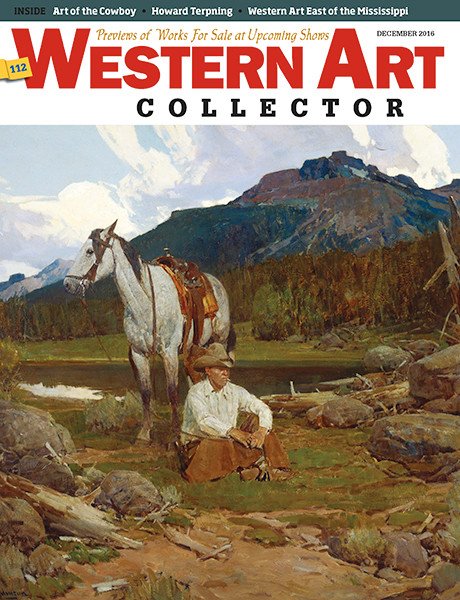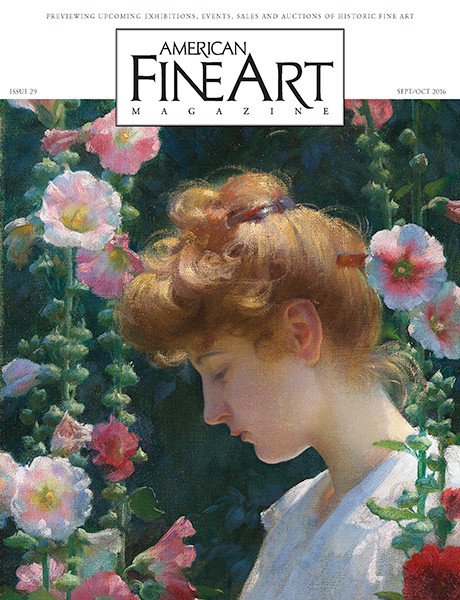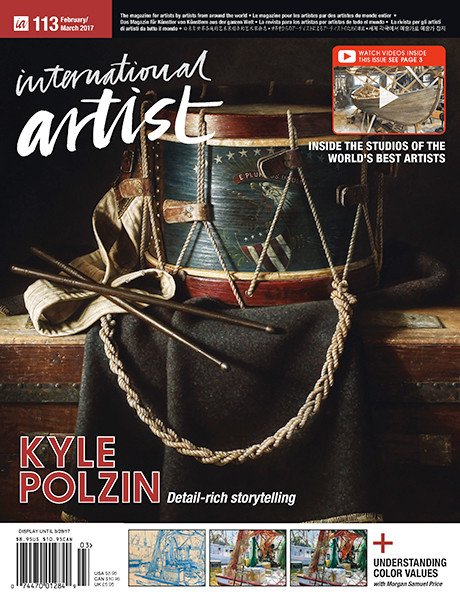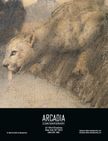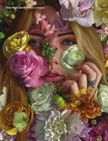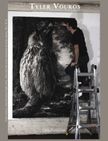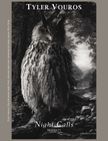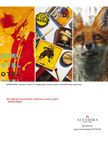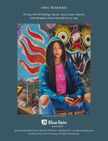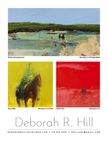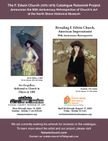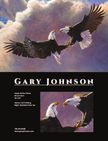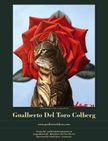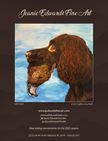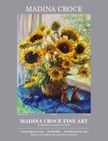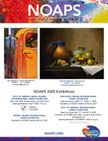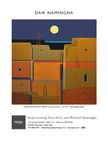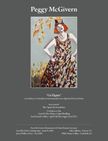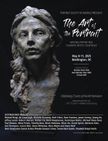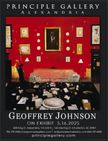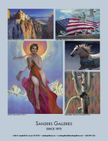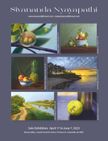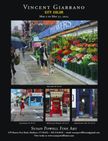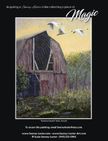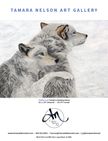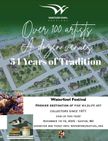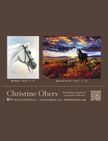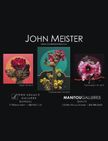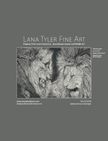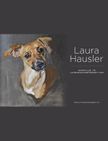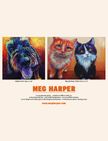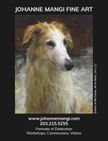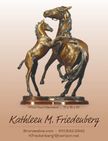In the world of Western art—“Western” as in cowboys and Old West subjects, not Western Hemisphere—there are a handful of painters that are widely considered masters of the genre. They range from former illustrators who turned to fine art, to Western purists in cowboy hats and boots, to classically trained figurative painters with books by Sorolla and Zorn next to bison skulls and Navajo blankets in their studio. In a category (nearly) by himself is Mian Situ, a Chinese American painter from Southern California who brought unique and historical perspectives into the genre. Situ was on top of the Western art world as one of its most acclaimed and distinguished stars. And then he walked away from it all.
But that’s not the end of the story—just the beginning of a new and very different chapter.

Mian Situ in his studio with Night, left, and Peacock Skirt.
Situ, untethered from his historical subjects, has turned his attention to gorgeously painted figures in magical and surreal settings, works that have been linked spiritually to the Renaissance and the Pre-Raphaelites of the mid-19th century. The 18 pieces, almost all created within the last two years, have largely been unseen by the public simply because they’ve been purchased as soon as the final brushstrokes were laid down. For Situ, the success of the paintings proves that artists should never feel stuck in one genre.
“I have always liked to paint very different things. I wish I had more time to do all I want to do. There was an old way of training artists: young apprentices followed a master painter in his studio to learn how he painted particular things. But the way I was trained was different and I like it. As a student I was taught the principles of art, including the way to think and the way to observe. Our teachers didn’t require you to follow certain styles. Styles are your own choice,” Situ says from his studio. “Once you are armed with the broad knowledge base you can develop your own style and choose you own direction. I believe that only when an artist follows his heart, he can be a good artist.”

Shadia in the Studio, oil, 46 x 36"
These redefining motivations in his studio shouldn’t be a surprise for those who know Situ’s life and career. He was born in South China and studied art in the rural countryside of Guangdong. Although China’s Cultural Revolution was in full force, the young artist was exposed to European and Renaissance art, which was forbidden by the Communist Party. After the 1976 death of Mao Zedong, the architect of the Cultural Revolution, travel opened up within China and young people flocked to see the outside world. Situ acquired a student visa and headed to the United States. He landed in Los Angeles in 1987 as an eager and hungry artist.

Candlelight, oil, 72 x 44"
His artwork at that time was a mixture of his old home and his new, with many paintings showing the experiences of Chinese immigrants as they interacted with American people, places and customs in settings like Gold Rush-era San Francisco, on railway lines cutting through the Sierra Nevadas and in the Canyonlands of Utah. Although not overtly Western—there were no bucking horses or longhorn cattle—his paintings spoke to an outsider’s cultural curiosity within the vastness and beauty of the Old West. His paintings also placed Asians in historically accurate settings that acknowledged their contributions in the creation of the American West.
And he was successful. Wildly so. Starting in 1995, Situ won awards at nearly every show he participated in, from the Oil Painters of America to plein air groups to the Masters of the American West at the Autry Museum of the American West. He has enough gold medals in his studio to pave a winding path from his front door to his street. His auction record stands at $431,000, and he has pieces in major public and private collections around the country. As a testament to his skill and talent, he even has works in the collection of Howard Terpning, widely acknowledged as the greatest living Western painter.

With Nature, oil, 72 x 42"
All of this makes his pivot away from Western art fascinating, albeit a bit complicated for his Western galleries.
Chris Sanders, owner of Sanders Galleries in Tucson, Arizona, first met Situ in the early 2000s and only started representing the artist recently. In 2023, Sanders saw some of his work at another gallery and, while the paintings were flawlessly executed, something was off about the pieces. “They felt uninspired. It didn’t seem right for an artist of Mian’s caliber. I had been in the art world professionally for 26 years, which is long enough to realize that an artist like Mian might have felt stuck,” Sanders says. “I wondered if he wanted to do something else. So I looked into it.”

Night, oil, 62 x 54"
Sanders, who was traveling at the time, went back to his hotel and immediately visited Situ’s website. It was there, behind a link labeled “Other,” where he found Shadia in the Studio. It was a profound discovery. “It’s a figurative piece, 46 by 36 inches, and it was the most brilliant figurative painting I’ve seen by any living artist,” Sanders says. “The figure is the hardest subject to paint. Artists who do it well, either they make it look like a photograph or they do it in the style of [John Singer] Sargent or [Anders] Zorn. It was academically excellent, but it was also just stunning. Here was this piece I was seeing on the website and I was comparing it to what I had just seen at his gallery. The difference was incredible.”

Oceana, oil, 56 x 56"
He drafted an email to the artist asking about Shadia in the Studio and complimenting its execution. “I sent the email and within almost 30 seconds an email came back, and I could sense his demeanor was inquisitive and he wanted to know why I was asking,” Sanders adds. “I told him the piece was magnificent and I asked if I could sell it for him. He told me, ‘Chris, you surprise me because this is the kind of painting I want to do most.”
It wasn’t long after that the two men were greeting each other in person at Situ’s California studio. They talked about John Everett Millais, William-Adolphe Bouguereau, John William Waterhouse, Sargent, Zorn and Situ’s older works. It was a vibe check, and they both felt comfortable with each other, so Sanders left with two paintings to begin showing collectors. Before leaving town to return to Arizona, Sanders went to lunch and texted one of his top clients, a collector who largely only collects work from deceased painters. The collector immediately bought one without even knowing the price. Sanders, still in Southern California, felt obligated to return to Situ’s studio to deliver the good news in person. “He opened the door and asked if I forgot something. I told him I sold the painting, and he looked down at the floor, sort of upset. I asked if I did something wrong. ‘Chris, I wanted to keep that one. I’m very happy, but please don’t sell the other one,’” says Sanders, who clocked that Situ hadn’t even processed that his new style could be sold so quickly. The other work, Shadia in the Studio,is still part of Situ’s personal collection.

Evening Elegance, oil, 48 x 56"
In 2023 and 2024, the artist and gallery owner were off to the races. Situ painted large and magnificent paintings of figures, and Sanders sold them as quickly as they were finished. The pieces went to top collectors, including to movers and shakers in important art circles on the East Coast. In a little more than a year, they sold more than $1.5 million in art.
Situ notes that his studio felt more alive than ever. “I think the human body is the most beautiful creature in the world. The structure, the color and the flexibility of it is amazing. It is a timeless subject for art. The pursuit of its beauty is endless. I use models for my paintings. The most ideal way to paint a human body is to paint from life. But there is a limit—some great movements or beautiful gestures cannot be achieved by a long still pose. A camera is very helpful nowadays,” he says. “My approach is more spontaneous even when I am working on a large canvas, which takes a month to finish. I have a vision about what I am going to paint before I work on the canvas. But once the process of the painting starts, I feel like what is already on the canvas will lead me where to go from there. The painting might end up different from what I plan. I think that is exactly the fun of painting. Life is fun because we never know what is going to be next.”

Iris Blossom, oil, 64 x 48"
He doesn’t rule out a future return to the Western genre, but Situ is also fully committed to this new trajectory within his studio. “I have been painting the genre of Western subjects for years. Artists need inspiration for new works and after you have to produce many works for a similar theme, your imagination feels somewhat run out. That is what happened to me while painting the old subjects. I felt that I was repeating the same things, and my desire and impulse to paint became weaker. I felt I needed some change,” he says. “Genre paintings always come with stories that happen in the present day or in history. They are challenging. A lot of time is needed in research and how to have the stories told uniquely. There is some limit to the freedom of expression of an artist. There are different kinds of art besides the genre painting. I like to refer it as ‘art for the sake of art itself.’ Artists always like to have more freedom in their creations…I think it is about time I should try something different now before it is too late for me. So I began to try to paint some new paintings for myself even if there is no market for it…It proves that when the artist puts their soul and effort into their work there will be people who feel the enthusiasm of the creator.”

Autumn Breeze, oil, 66 x 48"
There are also broader implications here for other artists: Situ proves that an artist should not feel bound to one identity. They and their work can, and probably should, change.
“Paint what makes you happy,” Situ adds. —
Sanders Galleries
Tucson, AZ, www.sandersgalleries.com
Powered by Froala Editor
